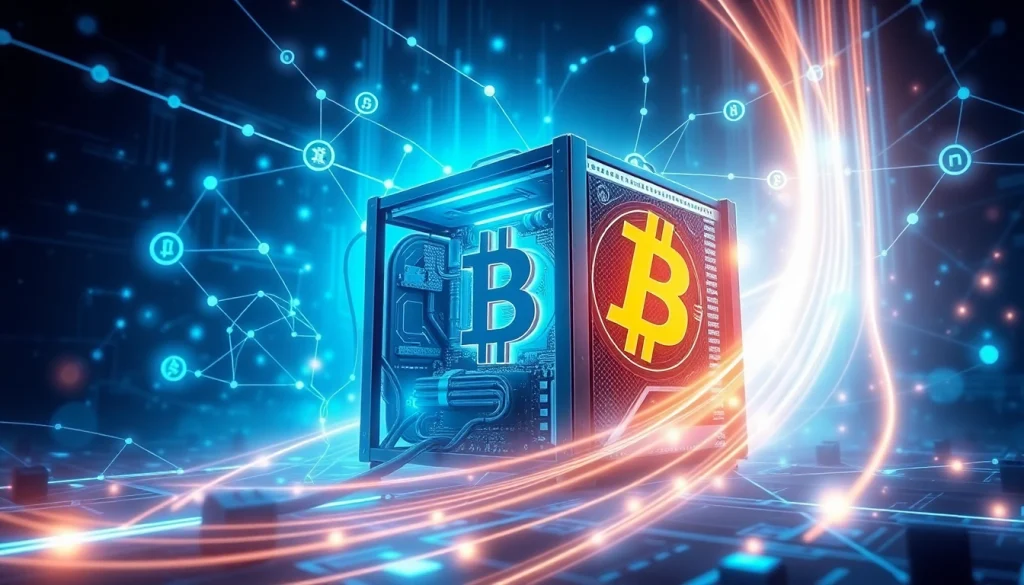The Ultimate Guide to Bitcoin Mining: Unlocking Cryptocurrency Potential

Understanding Bitcoin Mining: The Basics of Cryptocurrency
Bitcoin mining is at the core of the Bitcoin ecosystem, playing a crucial role in the maintenance and operation of the decentralized currency. As digital currencies pave their path through the financial landscape, understanding this unique process becomes pivotal for anyone interested in cryptocurrency. In essence, Bitcoin mining is both a technical and financial endeavor that requires an understanding of blockchain technology, the principles of cryptography, and the economic incentives that drive miners to secure the network.
What is Bitcoin Mining?
Bitcoin mining is the process by which transactions are validated and added to the blockchain, a public ledger of all Bitcoin transactions. It is also how new bitcoins are created. Miners utilize powerful computers to solve complex mathematical problems, specifically cryptographic algorithms, in order to verify transactions and secure the network. Each time a miner successfully solves a problem, they are allowed to add a block to the blockchain and are rewarded with newly minted bitcoins, along with transaction fees from included transactions. This dual incentive ensures that miners remain economically motivated to invest their resources into maintaining and securing the network.
How Bitcoin Mining Works
The mechanics of Bitcoin mining can be broken down into several key components:
- Block Creation: Transactions awaiting confirmation are bundled into a block. Each block contains the hash of the previous block, linking it to the blockchain.
- Hashing: Miners compete to solve a mathematical puzzle that requires them to find a hash below a certain target. This is achieved through trial and error, and the first miner to solve it broadcasts their proof to the network.
- Proof of Work: This is the fundamental mechanism that ensures security and consensus in the Bitcoin network, requiring computational work for mining. Once the proof is accepted, the block is added to the blockchain and the miner receives a reward.
The Importance of Bitcoin Mining in the Blockchain
Mining is pivotal to the functionality of Bitcoin as it provides the network’s security and integrity. Without mining, Bitcoin could be susceptible to various forms of attacks, including double spending, where a user attempts to spend the same Bitcoin twice. By making it computationally expensive and time-consuming to alter any part of the blockchain, mining thus ensures that it remains immutable. Additionally, the decentralization of mining — distributed across numerous miners worldwide — mitigates the risks of central points of failure or control.
Types of Bitcoin Mining: Methods and Techniques
Solo vs. Pool Mining: Which is Right for You?
When considering entering the Bitcoin mining space, one major decision is whether to mine solo or join a mining pool. In solo mining, an individual miner uses their own resources to mine Bitcoin independently. While the rewards can be lucrative, especially when successfully mining a block, the chances of this occurring are statistically lower due to the competitiveness of the mining network.
Conversely, pooling resources with other miners in a mining pool allows for more frequent, albeit smaller, payouts. Each miner contributes their computational power, and rewards are distributed based on participation. This could make mining more feasible for those with limited resources or for those just starting out.
Cloud Mining: Pros and Cons
Cloud mining offers an alternative method where individuals can rent mining power remotely, thus circumventing the need for expensive hardware. While it comes with its benefits such as lower upfront costs and no maintenance worries, cloud mining also has its fair share of drawbacks. Scams are rampant in the cloud mining space, and many services can prove unreliable. Users must conduct thorough research to identify legitimate providers before committing any funds.
ASIC vs. GPU Mining: Equipment Comparison
Mining hardware can be classified mainly into two categories: ASIC (Application-Specific Integrated Circuit) miners and GPU (Graphics Processing Unit) miners. ASIC miners are specially designed for the sole purpose of mining Bitcoin, offering high efficiency and power at a considerable price tag. In contrast, GPU mining setups are more versatile, capable of mining multiple types of cryptocurrencies, and are cheaper and more accessible for beginners.
Choosing the right equipment is crucial, as it can significantly influence the profitability of mining operations. Factors such as electricity costs, hardware efficiency, and initial investment should all be considered when deciding which mining method to pursue.
Getting Started with Bitcoin Mining: A Step-by-Step Guide
Setting Up Your Mining Hardware
Once you’ve determined your preferred mining strategy, the first step is setting up your mining hardware. This involves purchasing the necessary equipment such as ASIC miners or GPUs, as well as ensuring a reliable and efficient cooling setup to prevent hardware failure due to overheating. You’ll also need a stable internet connection and access to a power source that can support the energy demands of your mining operation.
Choosing a Mining Pool
If you opt for pool mining, selecting the right mining pool is essential. Consider factors like the pool’s size, reliability, fee structure, and payout method when making your decision. Researching pool reviews and engaging with the mining community can provide useful insights into the best options available.
Configuring Your Mining Software
After your hardware is set up and your pool is selected, the next step involves downloading and configuring mining software. Popular mining software includes CGMiner, BFGMiner, and EasyMiner. It’s crucial to follow the setup instructions carefully and to continuously monitor the performance and efficiency of your mining operation to maximize profitability.
Challenges in Bitcoin Mining: Common Issues and Solutions
Energy Consumption: Analyzing Costs
One of the most significant challenges facing Bitcoin miners is energy consumption. Mining operations require substantial power, leading to high electricity bills, which can negate profit margins. To combat this, miners are increasingly looking for cost-effective energy sources, including renewable options such as wind, solar, or hydroelectric power. Implementing energy efficiency measures, such as optimizing hardware settings or using advanced cooling technologies, can also significantly reduce overall costs.
Hardware Limitations and Scalability
As technology evolves, so do the demands on mining hardware. Many miners face the challenge of upgrading their systems to remain competitive in a constantly shifting environment. Scalability is also a vital consideration. Miners looking to expand operations should plan strategically, weighing the costs and benefits of additional equipment versus potential returns.
Dealing with Mining Difficulty Adjustments
Mining difficulty automatically adjusts approximately every two weeks, impacting the number of resources needed to successfully mine a block. Since difficulty increases as more miners join the network, existing miners must adapt to the changing landscape or risk losing profitability. Staying informed about changes within the Bitcoin network, experimenting with different mining strategies, and continually optimizing mining setups are essential for long-term success.
Future of Bitcoin Mining: Trends and Innovations
Impact of Regulations on Bitcoin Mining
As cryptocurrencies gain more mainstream attention, regulatory scrutiny has increased. Changes in laws can have significant implications for Bitcoin mining operations—from taxation to environmental regulations. Keeping abreast of legal developments not only ensures compliance but also informs strategic decisions to align with potential future market shifts.
Emerging Technologies in Mining Hardware
With the technological advancement of hardware, the future of Bitcoin mining is likely to be shaped by innovations in performance and efficiency. Upcoming developments include more advanced ASIC miners, GPU technologies, and even quantum computing, which promise to revolutionize how mining is approached. Staying informed on these trends allows miners to remain at the forefront of the industry.
The Role of Renewable Energy in Sustainable Mining
The environmental impact of Bitcoin mining has sparked a debate over its sustainability. The shift toward renewable energy sources is gaining momentum, as miners seek to reduce their carbon footprint. Companies leveraging renewable energy not only stand to attain greater competitiveness through cost-efficiency but also enhance their public image in an increasingly eco-conscious market. Investing in green technology may become a standard for future sustainability-oriented mining practices.







